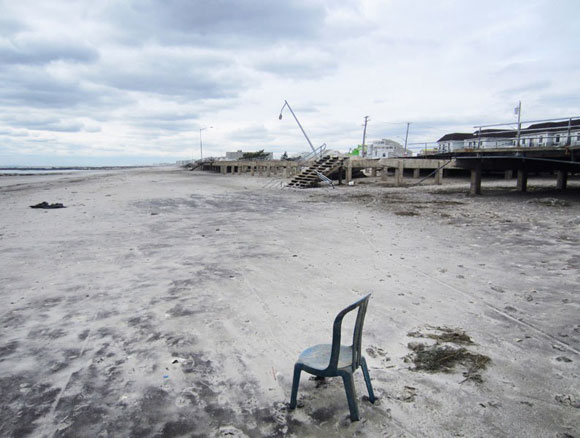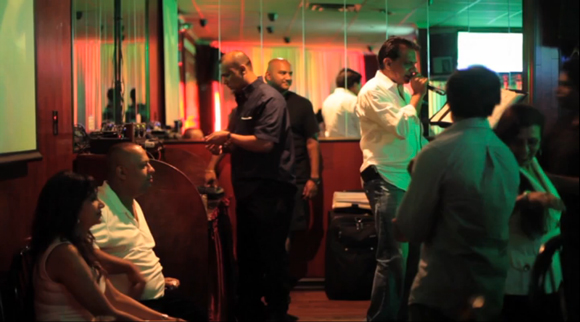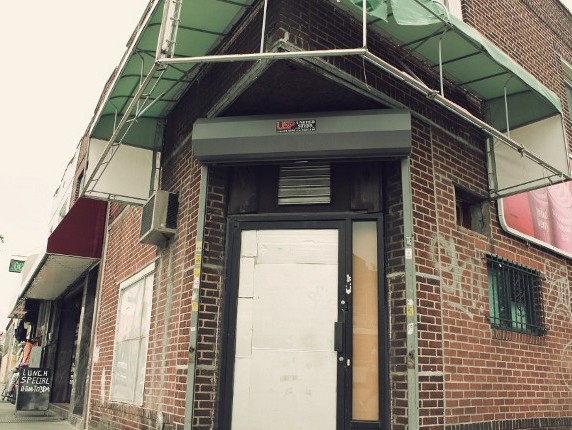It’s Sunday morning and there’s a debate underway at the Richmond Hill Flea Market in Queens. At issue: a pair of bejeweled, costume earrings made of faux diamonds and rubies.

February 1, 2014
It’s Sunday morning and there’s a debate underway at the Richmond Hill Flea Market in Queens. At issue: a pair of bejeweled, costume earrings made of faux diamonds and rubies.
“Auntie, give me ten dollars,” said the vendor, Raj, a recent immigrant from Punjab, India. He added emphasis on the word “Auntie,” and spoke Hindi, while Saima, originally from Pakistan, responded in Urdu.

“Five, give it to me for five,” protested Saima. She called her husband over to help. He shrugged. He was only there to finalize the transaction, not partake in the process.
The three shared a laugh over her suggested 50% discount, and Raj guided her toward another pair of sparkly earrings with a more conservative price.
While interactions like these—between Raj and Saima–an Indian and a Pakistani–might have never occurred back in their home countries, they’re common at the Richmond Hill Flea Market, where shoppers and vendors mingle and haggle, despite the tenuous borders of their homelands.
Longstanding unemployment in this neighborhood, as well as insufficient disability checks, make the Richmond Hill Flea Market a viable option to make ends meet for vendors. Dave Forest, the co-owner of the market, explained recently, “A lot of people don’t work during the week, and this is all they do. The fact that we’re indoors, there’s some people that are elderly that can’t be outside with the elements. Here, they feel happy and useful.”
Longstanding unemployment in this neighborhood, as well as insufficient disability checks, make the Richmond Hill Flea Market a viable option to make ends meet for vendors.
The unemployment rate in Queens is 8%, in line with the national average. According to the Queens Economic Development Corporation, nearly a third of Richmond Hill households make less than $35K, more than half of these are immigrant families.
“After I became unemployed, I started selling here,” recalled Joan Giacomontonio, a new vendor at the market. “I started connecting with Muslim customers who kept returning for my jewelry.” She pointed to a set of rings etched with Arabic script. “So, I wanted to connect with them, and started selling jewelry that they want to buy. It’s been really good for me.”

The weekly Sunday market stands between two vibrant commercial corridors, Liberty Avenue and 101st Avenue, and is housed in the former RKO theater, which was built in 1929 and was part of the U.S.’s earliest large theater chains. Back then the RKO Richmond Hill attracted patrons with its state of the art sound system, Orpheum Vaudeville stage acts, and Hollywood films. Its last film was the 1967 Marlon Brando-Liz Taylor drama “Reflections in a Golden Eye.”
For 30-years, it was the neighborhood’s only dinner-and-movie theater. But by the late 1960s, there was a palpable change in the city and Richmond Hill was not immune to the strife taking hold of the five boroughs. 1968 was one of the most tumultuous in NYC history, with labor struggles worsening racial and class tensions, the nine-day sanitation workers strike resulting in garbage strewn streets, and the United Federation of Teachers strike pitting Black and Jewish communities against one another. The theater, a bastion of better times, finally shuttered its doors; the costs of running the enormous space were simply too much. Ever since, it has operated as a neighborhood flea market and bingo hall.
“I don’t even want to imagine how much it would cost to renovate this place,” remarked Dave Forest, while giving a tour of the upstairs theater space. He’s the reluctant heir to the Flea Market, which was started by his father Louis the same year the theater closed. Forest didn’t grow up in Richmond Hill, but on Staten Island, and his only tie to this community remains the flea market.
“I don’t even want to imagine how much it would cost to renovate this place,” remarked Dave Forest…the reluctant heir to the Flea Market. It was started by his father Louis the same year the theater closed.
Vestiges of the theater’s old grandeur are still in place, and the vaulted ceiling bears ornate crown moldings and half-broken chandeliers. Down below, there’s the bustle of vendors and patrons, like Raj and Saima, bargaining on silver jewelry, sundries, and antique knickknacks.

“We closed for a two-year renovation period in 2010-2012, just to bring the venue up to code,” said Forest. Since he inherited the flea, he’s overseen the market’s operation, but he keeps it distinctly separate from his everyday life. “I’m just here helping out,” explained Forest, “Just come in Sundays to make sure everything’s running smooth. It’s social here. It’s friends meeting friends. The vendors all know each other. Everyone’s an entrepreneur.”
At Richmond Hill Flea Market, licensed vendors sign up weekly, so there’s no monthly fee or commitment required. For $40, vendors take advantage of one of the cheapest vendor fees in a city of flea markets. It’s a democratic division of space, as well, with each vendor getting a folding table’s worth of space for their wares. Trendy markets like the Brooklyn Flea run vendors between $120-$275 per table.
The location and early hours of the market appeal to an elderly clientele, who’ve come to count on it as a Sunday pastime. It’s a different scene than the Brooklyn Flea, which attracts legions of younger customers with handmade jewelry, arts and furniture made by local designers. The Richmond Hill Flea market is an amalgam of vendors’ antique finds, with a focus on quantity over curated goods.

“I used to work at a Jewish Community Center. When one of these elderly people died, they would leave me their stuff. They were good to me,” said Jose, another longstanding vendor with over 20 years in the antiques game. Since his days working at the nursing home, he’s transformed his hobby into a full-time profession. He’s learned about Waterford crystal or Waltham watches through conversations with relatives of the deceased, the auctions and estate sales he’s procured merchandise from around New York State.
Each Sunday, Jose meticulously arranges his antiques in an old popcorn stand at the helm of the market—a prime location for foot traffic. Having been at the market for more than a decade, with an eclectic range of sellable goods, Jose has dibs on this prime real estate. “These things are accumulations of things from other people. Once I realized what I had—crystal, antiques, and [understood] the value for it—I knew I could sell it.”
Jose is among one of the most successful vendors, which he attributes to his understanding of the ever-changing neighborhood. Jewish and Irish immigrant communities comprised Richmond Hill’s population in the early days of the flea market, but in the last fifteen years, Richmond Hill’s newest immigrant families, mostly Pakistani, Afghan, and Iraqi, walk up and down the rows looking for deals.
However, running a successful operation at the flea market is rife with challenges. The money isn’t a guarantee–one week might yield as little as $30, another as much as $600. The inconsistency of profits makes the business difficult, explained Giacomontonio. Still, she’ll stick to selling while she looks for work.
Jose is among one of the most successful vendors, which he attributes to his understanding of the ever-changing neighborhood…in the last fifteen years, Richmond Hill’s newest immigrant families, mostly Pakistani, Afghan, and Iraqi, walk up and down the rows looking for deals.
The post-holiday season is the slowest time of year for vendors. While outdoor markets like Brooklyn Flea are closed until Spring, Richmond Hill Flea stays open, although freezing temperatures and retreating shoppers make for less business. “When I [actually] make money, I like doing it,” said Joseph, a seasoned vendor who’s been at the flea 30 years. Once he fancied himself a journalist, until he got roped up in a dangerous story involving a cult. After that, the flea market became a mainstay of his income. These days, Joseph finds most of his antique sterling silver wholesale on eBay. “But it’s nothing you can count on. Two months before Christmas is when it gets busy. Other than that, it’s hit or miss.”
“My friends were telling me it’s a good place to find lots of jewelries,” said Raj, translating for Saima, who eventually settled on the original earrings for $10. Many of the shoppers peruse the aisles, languidly pushing strollers, filling their bags with $1 cleaning supplies or $5 plain white t-shirts, in addition to a rare piece of jewelry that would be triple the cost elsewhere.
Two regulars at the flea market, Mayra and Leydi, have developed strong relationships to vendors, who tip them off to new merchandise. For her birthday, Leydi spent fifteen minutes making a deal with joseph for a carnelian necklace from Tibet.
“I’ll give it to you for $40, it should be $60, but I like you, so you’ll get it for a nice price,” said Joseph, sounding every part the salesman.
Leydi sighed. “All right, fine. I take it.” She gave one last look to the large-beaded necklace and handed Joseph a few bills, as most vendors still do business cash-only.
Convenience is a luxury here. It’s a one-stop shop for virtually anything. “I get a lot of my clothes here,” says Joseph, pulling at his button-down shirt. “We all support each other by buying from each other. That’s another nice thing I suppose.”
“This is not my way of spending a Sunday,” admitted Andy Henry, who, at 16, might be one of the youngest vendors in the market. “It sort of kills my Saturday night. But it’s been good for my mother, Hemmootee.” He glanced at her, while she busily sold a piece of Indian costume jewelry to a customer. “My mom’s been doing this since she was a child in Guyana. She likes the conversations with people. She likes making her own business.”





